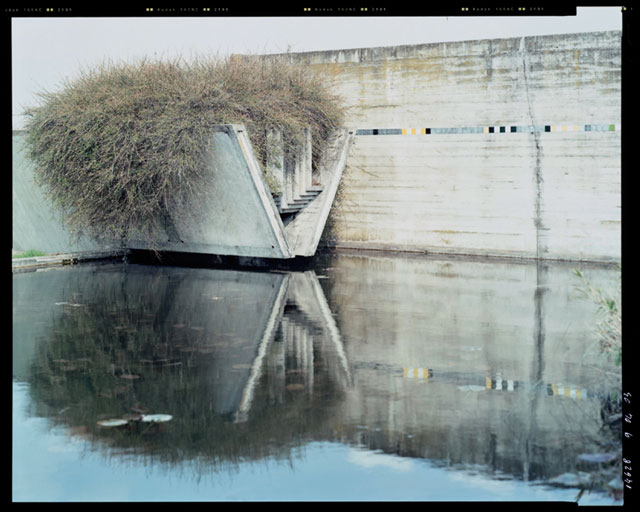[Spring 2010]
CCA, Montreal
September 11, 2009, to January 10, 2010
Nestled within the CCA’s Octagonal Gallery in conceptually elegant fashion, this thematic body of photographic work by the Italian photographer Guido Guidi paid tribute to an architectural masterwork while highlighting his own various strengths and idiosyncrasies as a creative artist preoccupied, for the last several decades, with landscape and its transformations. Guidi’s extended visual essay is remarkable on several counts. Carlo Scarpa’s Tomba Brion – a family mausoleum in Italy that is widely acknowledged as being one of the architect’s masterworks – is subjected here to Guidi’s methodical deconstruction of its physical structure, encompassing its temporal and spatial dimensions. A long-time devotee of Scarpa’s work, Guidi brings to bear a contemplative focus – and one that powerfully informs this decade-spanning visual essay.
The fifty-four colour photographs build up a rich palimpsest that reveals the stark beauty of the funerary complex. Guidi’s exceptional palette is always in evidence in this splendid array of images culled from a decade-long investigation.
At first, a sense of the funerary complex as an unfettered whole is found to be elusive. This is precisely Guidi’s intention, of course. He wants to lead us beyond the whole into the wealth of the constituent parts, so that we might better appreciate the nature of the architect’s achievement. He selects revealing but limited views of the interior and exterior of the structure. After only a few moments, we begin searching for a sense – or image – of the overall structure. It soon becomes clear that only by travelling alongside Guidi through all fifty-four views – and then retracing our steps – will this be possible, and then only in terms of what is adumbrated there, not actually made explicit: a sort of “meta-documentation” that reads as the photographic side of a pristine collaboration with the architect.
Upon closer inspection, we note a strange and compelling particularity in the photographer’s chosen views. It is no exaggeration to suggest that Guidi’s methodical and poetic approach is almost phenomenological in its scope, tenor, and intent. In freely varying his perspectives on the tomb complex not only in space but in time, he arrives at the truth of its architecture; an abiding sense of its essence. He works his own highly effective eidetic reduction – the subsequent distillation of all of the images that he has taken into the core archive presented here – in order to arrive at what is most pertinent and to name the architect’s extraordinary achievement. Everything else is left by the wayside.
Guidi worked over a ten-year period to acquire an extensive series of views of the funerary complex. Collating appearances of the funerary complex at different times and in different seasons, he became a collector of fragments that add up to an unforeseen holistic experience. Profoundly acquisitive, Guidi collated the “evidence” afforded by his photographs and secured a ruminative triumph. It should be pointed out that the inordinately deft installation of the photographs mirrors Guidi’s operative methodology and draws upon the viewer’s own constitutive process.
That Guidi’s phenomenological method is not limited to the Scarpa essay may readily be seen by looking at his other work. Another revealing example of his approach would be his photographs of bunkers along the Atlantic Wall. Built by German occupation forces from 1939 to 1944 along the coasts of France, the Channel Islands (Great Britain), Belgium, the Netherlands, and Germany, the bunkers formed one of the last major defence lines of the twentieth century. Guidi always attends to specific details of the infrastructure, parsing them out in deft and orderly fashion so as to dramatize the whole accordingly. He shifts his position incessantly, in order to elicit a host of different perspectives. Obliquely surveying the structures in their specificity means, paradoxically, summoning up a sense of their holism from the sum total of their fragments. This radiant methodology can be found in all of his work.
In the Brion tomb investigation, Guidi leads us over the threshold of contemplation. By noting the different times of the day at which each image was taken, he specifies the temporal as critical to the appearances. By pinpointing features of the architectural, he sheds light on the spatiality. And he is luminocratic: the free play of light in his images is everywhere at work, investing them with textural luminosities that highlight the grandeur of Scarpa’s achievement. Guidi has said, “In essence, I considered Scarpa’s architecture not only as a manufactured object, but also as a machine through which to look at time. Or rather, architecture in its ‘becoming,’ as shadows on a wall that recall volumetric projections drawn in countless mutations on a sheet of paper.”1
Throughout his career, Guidi has earned an enviable reputation for clarity. He has developed a phenomenally cohesive corpus that is as rigorous as it is poetic. Ably curated by Louise Désy, CCA curator of photography, the exhibition was yet another triumph of scholarship and discovery at the CCA. Photographer, phenomenologist, and poet, Guido Guidi emerges here as a photographic artist of the first water.
1 Guido Guidi, quoted in the press release.
James D. Campbell is a writer on art and independent curator based in Montreal. The author of over 100 books and catalogues on contemporary art and artists, he contributes frequently to visual arts publication across Canada.


